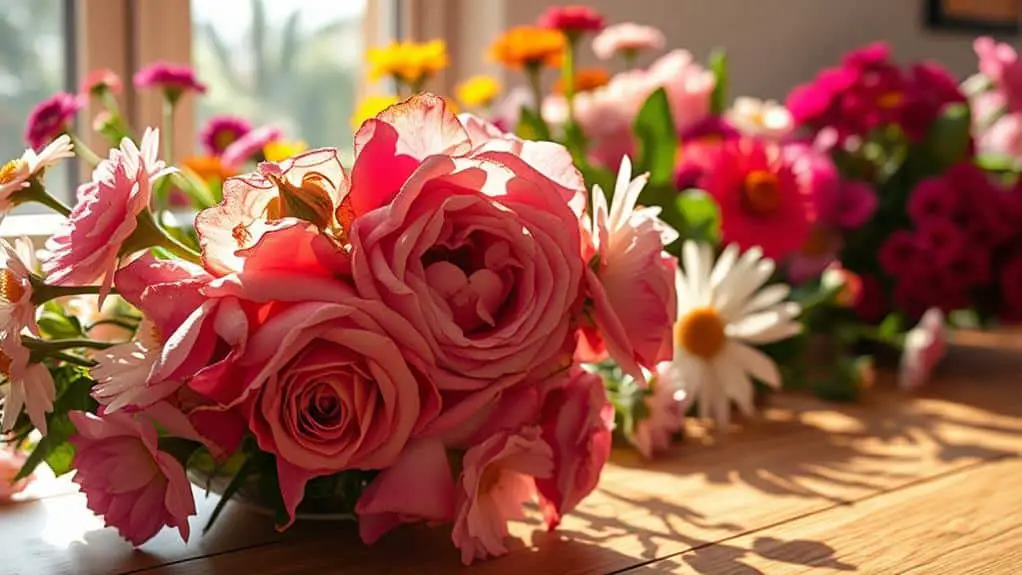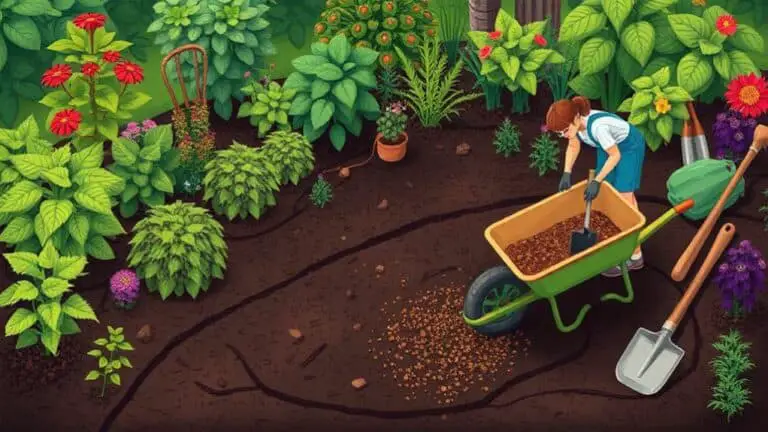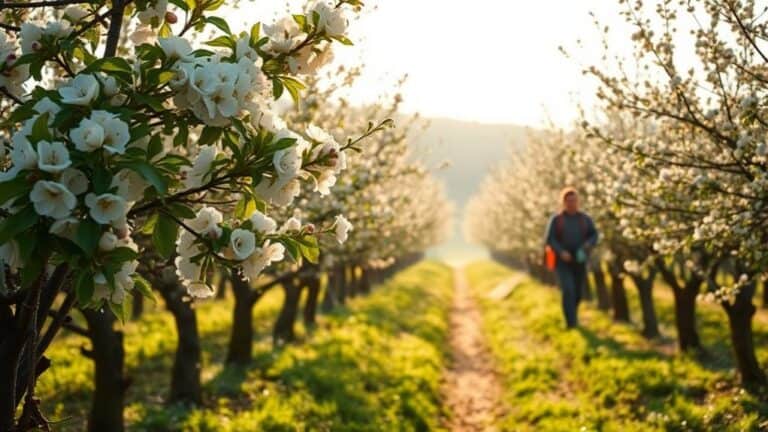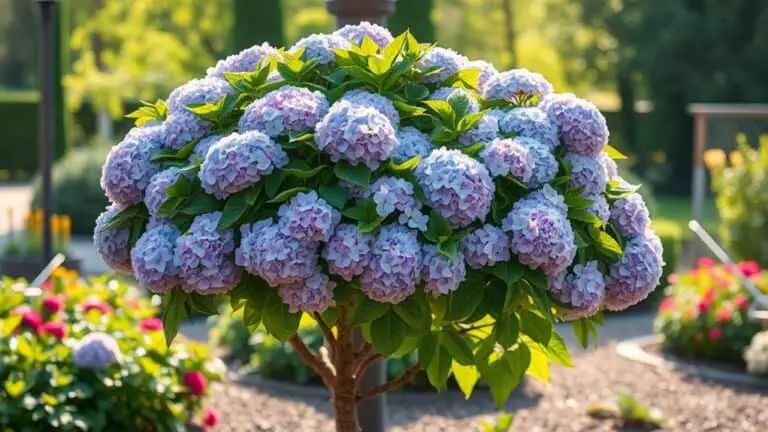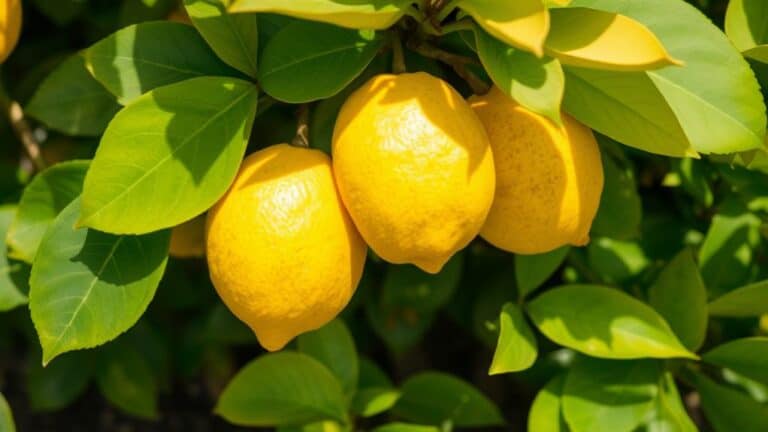How Long Can Cut Flowers Last Without Water
When it comes to the longevity of cut flowers without water, I often find myself curious about the factors that influence their survival. Different species have varying lifespans, with roses lasting a few hours and carnations enduring up to half a day. Environmental conditions, like temperature and humidity, also play significant roles in their freshness. Have you ever wondered how some flowers manage to stay vibrant longer than others? Stick around, and I'll share some interesting insights and practical tips on how to maximize the lifespan of your floral arrangements.
Duration of Cut Flowers
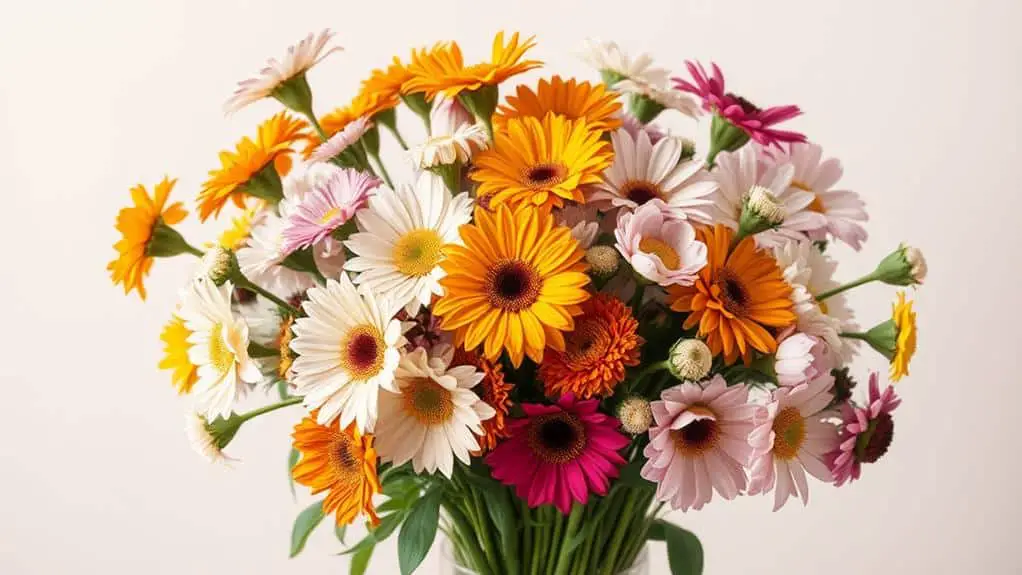
When considering how long cut flowers last without water, it's vital to understand the varying resilience among different types. Most cut flowers can survive for only a few hours without water, but hardier varieties like roses and carnations fare better.
For example, roses can wilt within 4-6 hours without water yet last up to three days if properly hydrated beforehand. Carnations are even tougher, enduring about 12 hours without water and typically lasting 1-2 days.
Lilies offer a broader range, lasting between 2 to 10 days depending on their freshness and conditions. On average, bouquets without water show signs of wilting and browning within 24-48 hours, though they might last around 5-7 days in total.
Flower Species and Longevity
Understanding the longevity of various flower species without water can help you make informed choices for your floral arrangements.
Some flowers can last longer than others, making them ideal for situations where water isn't readily available.
Here's a quick guide to help you:
- Roses: They typically last 4-6 hours without water, but can survive up to 3 days in favorable conditions.
- Carnations: Known for their hardiness, they can endure up to 12 hours without water, generally lasting 1-2 days.
- Lilies: Depending on their freshness, they can last 2-10 days without water.
- Tulips: If stored correctly in a cool, partially closed environment, they can survive about a week without water.
Choosing the right flower species guarantees your fresh flowers last longer, even without water.
Environmental Impacts

Have you ever wondered how environmental factors play a significant role in the longevity of your cut flowers?
Well, it all starts with temperature and humidity levels. Keeping flowers at an ideal temperature, around 35°F to 37°F, helps prevent wilting and extends their life. High humidity levels are also essential because they slow down the drying process, giving your flowers a longer-lasting freshness.
On the other hand, low humidity and exposure to direct sunlight speed up evaporation, causing your flowers to wilt faster. Air circulation can be a double-edged sword; it can help maintain moisture but can also dry out flowers if too strong.
Considering these environmental factors can make a big difference in how long your cut flowers last.
Temperature Effects
We've seen how environmental factors like humidity and sunlight can impact the longevity of cut flowers.
Now, let's talk about temperature effects. Keeping cut flowers in cooler environments is key to maintaining their freshness. The ideal temperature range is between 35°F and 37°F.
Here's how different temperatures affect flowers:
- High temperatures: Found in cars or near heating vents, these cause faster wilting.
- Direct sunlight: Increases evaporation rates, leading to quicker water loss.
- Cooler environments: Help extend the time flowers can go without water by slowing down moisture loss.
- Stable temperatures: Fluctuations can stress flowers, reducing their overall lifespan.
Humidity and Freshness

Humidity plays an essential role in keeping cut flowers fresh. When the air has high humidity, it helps reduce moisture loss through evaporation, allowing flowers to stay vibrant longer.
Ideal humidity levels between 50-70% are perfect for retaining moisture and prolonging freshness. If the air is too dry, flowers can wilt quickly, showing signs like drooping petals and browning leaves.
To combat low humidity, you can wrap a damp cloth or paper towel around the stems during transport. This trick helps maintain moisture, giving your flowers a better chance to stay fresh.
Importance of Cleanliness
Cleanliness is essential when it comes to extending the life of cut flowers. You see, using clean water and maintaining hygiene practices can make a big difference.
Here's why:
- Prevents bacterial growth: Clean water stops bacteria from multiplying and harming your flowers.
- Reduces decay: Fresh, cool water helps keep flowers hydrated and prevents wilting.
- Keeps containers clean: Regularly cleaning vases stops bacteria from building up.
- Removes rotting leaves: Taking off leaves that will be underwater keeps the water clean.
Flower Preparation Tips
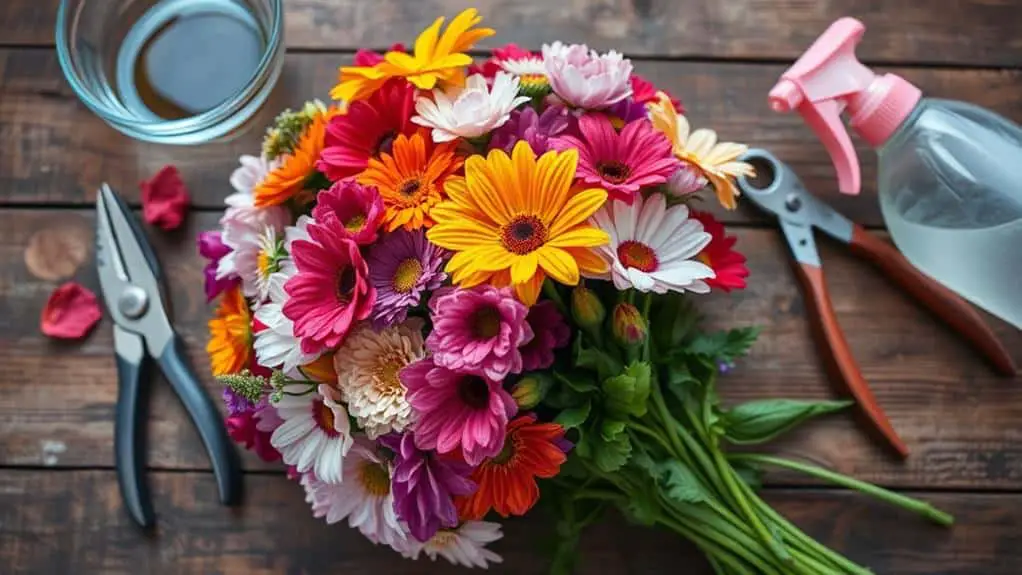
To keep your cut flowers looking fresh, start by trimming the stems at an angle just before placing them in water. This helps them drink better and prevents flat ends from blocking water flow.
Also, make sure to remove any leaves that will be underwater to stop bacteria from growing and keep the water clean.
Proper Stem Cutting
When preparing cut flowers, guaranteeing proper stem cutting is essential for their longevity and vigor.
Here's how you can provide the proper care to guarantee your cut plants absorb water effectively:
- Cut at a 45-degree angle: This maximizes the surface area for water absorption, preventing stems from resting flat on the vase bottom.
- Trim under water: Either under running water or submerged, to avoid air bubbles that hinder hydration.
- Use sharp, clean tools: Dull scissors or shears can crush stems, reducing water uptake.
- Remove submerged leaves: This helps prevent bacterial growth, keeping your flowers fresher longer.
Optimal Storage Conditions
One of the key steps to ensuring your cut flowers stay vibrant and fresh is optimizing their storage conditions. First, keep them in a cool environment, ideally between 35°F to 37°F. This helps maintain their freshness. Before placing them in a vase, always trim the stems at an angle to enhance water absorption and prevent clogging. To prevent dehydration, wrap damp cloths or paper towels around the stems if they are without water for a short time. Also, avoid direct sunlight and heating vents to minimize wilting.
Here's a quick reference table:
| Tip | Action |
|---|---|
| Cool Environment | Store at 35°F-37°F |
| Trim the Stems | Cut at an angle |
| Prevent Dehydration | Wrap stems in damp cloths |
| Avoid Sunlight | Keep in shaded areas |
| Keep Away from Heat | Avoid heating vents |
Maintaining Freshness
Making sure your cut flowers stay fresh and vibrant isn't just about placing them in water; it's a bit more nuanced.
To guarantee your flowers can last, follow these steps:
- Trim the stems at an angle: This improves water absorption.
- Keep them cool and shaded: Avoid direct sunlight and heat.
- Change the water regularly: Clean containers help keep your flowers fresh and prevent bacterial growth.
- Use damp cloths for transport: Wrap stems to retain moisture.
Water Retention Techniques

To keep your cut flowers looking their best even without a vase full of water, mastering water retention techniques is key. Start by trimming the stems at an angle to enhance water absorption. This prevents flat ends that inhibit hydration. Wrap damp cloths or paper towels around the stems to retain moisture during transport or brief dry periods. Use clean, cool water with floral preservatives to provide nutrients and prevent bacterial growth. Store flowers in a cool, shaded area away from direct sunlight to reduce evaporation and wilting. Change the water every few days and remove submerged leaves to prevent rot and keep the water clean.
| Technique | Purpose | Benefit |
|---|---|---|
| Trim stems at an angle | Enhance water absorption | Better hydration |
| Wrap stems with damp cloths | Retain moisture | Prolong freshness |
| Use clean, cool water | Provide essential nutrients | Extend lifespan |
| Keep flowers in a cool area | Reduce evaporation | Maintain freshness |
| Change water regularly | Prevent rot | ideal hydration |
Long-Lasting Flower Varieties
Let's talk about some flowers that last a long time even without water.
Roses and chrysanthemums can go for a whole day, while zinnias and delphiniums can stay fresh for weeks.
With tips on hardy species and care practices, you'll keep your arrangements looking great.
Hardy Flower Species
When it comes to creating stunning floral arrangements that can withstand the test of time, hardy flower species are the way to go.
These flowers can last without water for impressive periods, making them perfect for long-lasting displays. Here are a few examples:
- Zinnias, Chrysanthemums, and Delphiniums can last several weeks without water.
- Carnations are incredibly resilient, surviving up to 12 hours without water.
- Roses can endure approximately 4-6 hours without water.
- Lilies can survive around 2-10 days without water, depending on their freshness.
These hardy flower species aren't just beautiful but also practical for anyone looking to keep their arrangements vibrant for longer periods.
Extended Longevity Tips
Aiming for a floral arrangement that lasts? Let me share some extended longevity tips to make your flowers last.
Choosing the right varieties is key. For instance, Zinnias, Chrysanthemums, and Delphiniums are hardy and can last several weeks without water.
Roses are quite resilient too, surviving up to 3 days without water. If you prefer Carnations, they can endure about 1-2 days.
Lilies vary, lasting anywhere from 2 to 10 days, depending on their freshness and environment.
Succulents and cacti are also great choices since they retain moisture well.
Optimal Care Practices
Selecting the right flower varieties and employing ideal care practices can greatly extend the life of your arrangements. Some flowers naturally last longer than others. For instance, roses can live up to 3 days without water, while carnations can endure around 12 hours.
To keep fresh flowers lasting longer, consider these best care practices:
- Choose hardy varieties like zinnias, chrysanthemums, and delphiniums. They can last several weeks without water.
- Select flowers that are just starting to open. Peak freshness at cutting time helps.
- Trim stems at an angle and remove submerged leaves. This promotes better water absorption.
- Store flowers in a cool, shaded area. Keep them away from direct sunlight and heat.
Frequently Asked Questions
How Long Will a Bouquet of Flowers Last Without Water?
I've found that flower types' longevity varies, and environmental factors影响 their freshness. Using flower preservation techniques, most bouquets last 24-48 hours without water. Roses wilt quickest, while lilies endure longer. Pre-hydration can also help.
How Long Do Flowers Stay Fresh After Cutting?
When I cut flowers, I focus on flower preservation techniques to keep them fresh. I guarantee ideal temperature conditions and use flower nutrient solutions. This helps maximize their freshness for several days after cutting.
Do Cut Flowers Need to Be in Water?
Absolutely, cut flowers need to be in water. For proper flower care, place them in a clean vase with fresh water and use floral preservatives. Hydration methods like misting can also help extend their freshness.
Why Does Sugar Help Flowers Last Longer?
Sugar solution benefits flowers by providing energy, promoting nutrient absorption, and aiding floral preservation techniques. It helps maintain turgor pressure and prolongs freshness, making nutrients absorption important for vibrant colors and extended vase life.
Conclusion
In the end, keeping your cut flowers fresh without water is all about choosing the right varieties and giving them the best conditions. Remember, some flowers like carnations and zinnias last longer, while others need more care. Keep an eye on temperature and humidity, and try to keep your flowers cool. By following these tips, you'll enjoy your beautiful blooms for as long as possible. Happy gardening, and trust that you've got this!

